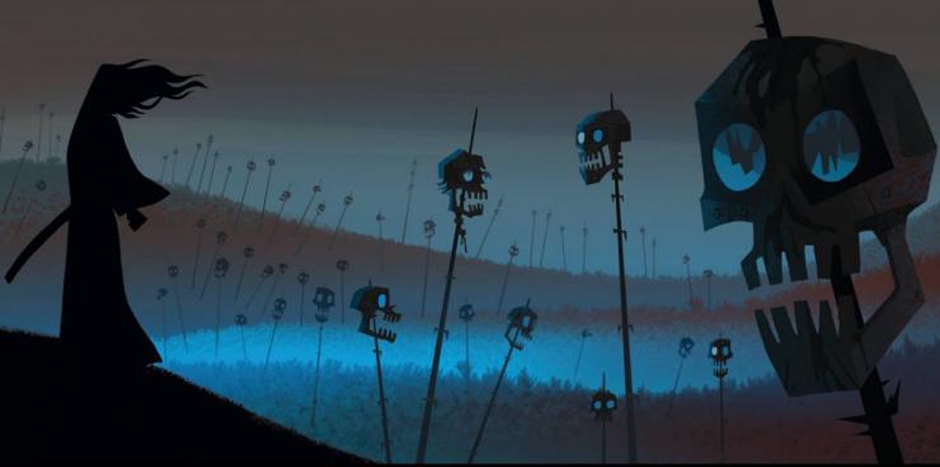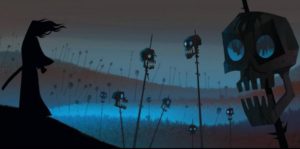

The show’s fifth season features a much darker tone than previous ones. The titular character, Jack, battles with suicidal thoughts, and humans are shown dying for the first time.
By Sean Ray | A&E editor
More than a decade after it originally ended, the critically acclaimed animated series “Samurai Jack” has made a triumphant return to the world of television. A classic from Cartoon Network’s lineup in the early 2000s, the series is now airing a fifth and supposedly final season on Adult Swim, CN’s late-night, more mature programming block, with the first three episodes already aired.
The plot, which was reiterated at the start of every episode for the first four seasons, follows the eponymous Samurai Jack, a warrior from an ancient world who was flung into the future by the demon Aku. Trapped in a science-fiction-based society where his nemesis rules over all, Jack seeks a portal back in time to undo Aku’s evil and return the world to what it was.
Season 5 takes place a further 50 years into the future. Due to his time displacement, Jack has ceased to age. However, what seems like a boon becomes more of a curse, as Aku has successfully destroyed all of the portals back in time, while Jack has lost his sword, the only weapon capable of harming his foe. Without purpose and mentally broken, Jack wanders aimlessly, pursued by the Daughters of Aku, a cult seeking the samurai’s death, and a mysterious spectre.
“Samurai Jack” was always a gathering of the best pieces of fiction. Its episodes combined mythology, folk-lore, manga, comic books, films and many more sources into one concise package. Each episode was radically different from the one before it, jumping between comedy to seriousness at the drop of a hat.
Season 5 continues this tradition, but on a micro-scale. For example, the second episode of the season had me laughing my sides off at the beginning, incredibly depressed in the middle and sitting on the edge of my seat for the end. Such a roller-coaster of tone might have failed in other shows, but series creator Genndy Tartakovsky makes it all flow seamlessly.
Speaking of which, the fact that much of the original cast and creative teams returned a major plus. While Mako Iwamatsu, the original voice of Aku who tragically passed away in 2006, can never be truly replaced, Greg Baldwin does a decent take on the character.
A major boost comes in the art department, with many scenes coming across as jaw-droppingly gorgeous. Negative space is used incredibly effectively, as well as cinematic camera angles in dramatic moments. Film aficionados will even find a famous scene from “The Good, The Bad, and The Ugly” lovingly referenced.
The jump to a more mature programming block invariably means that some of the restraints the original series had have been removed. Blood shows up, and yes, people do die. But what is most surprising is how restrained and natural it feels. Deaths are not over-the-top, nor is gore shown, and the blood itself seems to take on a beauty of its own in some moments.
In a very refreshing viewpoint in this modern world, the show avoids moralizing killing as would be expected. While Jack does regret having to take a human life for the first time, it does not utterly bring him down, reasoning that his opponent’s choices in life were as much to blame for their demise as his choice to kill them. It’s an alternative take in this world where no-killing superheroes seem to control 90 percent of entertainment.
The only real negative that can be found is the rather staggering number of animation errors which seem to crop up in each episode. Admittedly these were only noticed on second or third viewings, but they’re quite bad. The seven Daughters of Aku become eight in one scene, weapons vanish and reappear at will and even character positions alter without a sign they were supposed to.
But despite all that, it takes nothing away from the experience. Honestly, this season has astounded me with its quality. After thinking that the first episode was essentially perfect, I was shocked when the next episode utterly blew it away, only for the third episode to do the very same thing.
Whether you’re a fan of the original or not, “Samurai Jack” Season 5 is a must-see for everyone. It’s funny, it’s touching and it is easily the best thing on TV right now. The bar has been set for quality animated programming, and it is going to be a tough act to follow.
“Samurai Jack” Season 5 airs every Saturday at 11 p.m. Be sure to catch up before the next episode airs.



